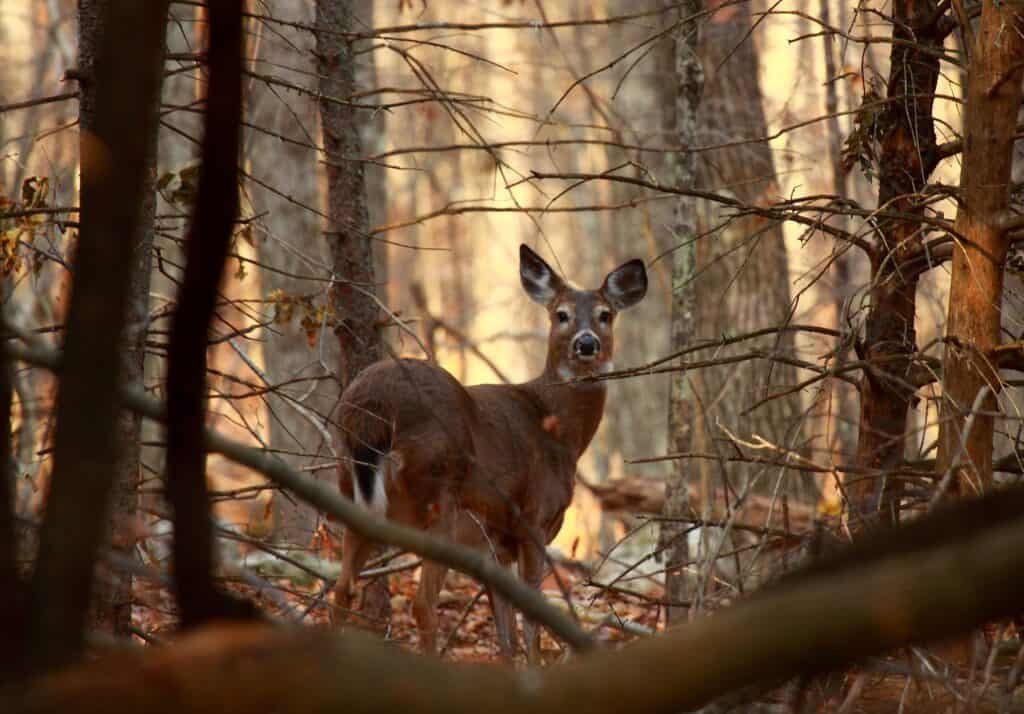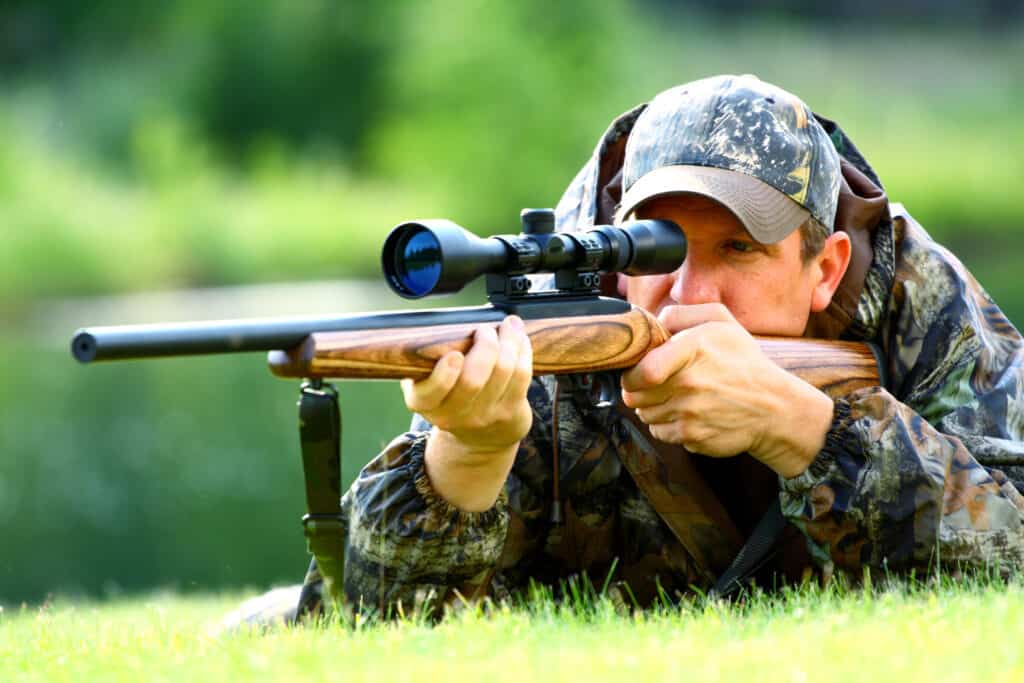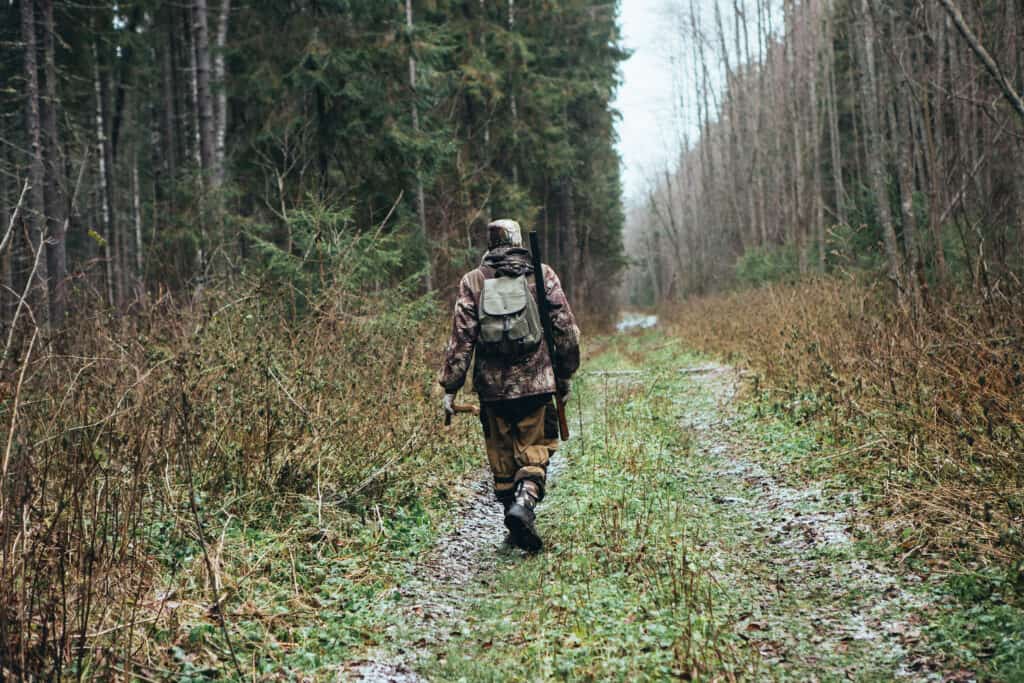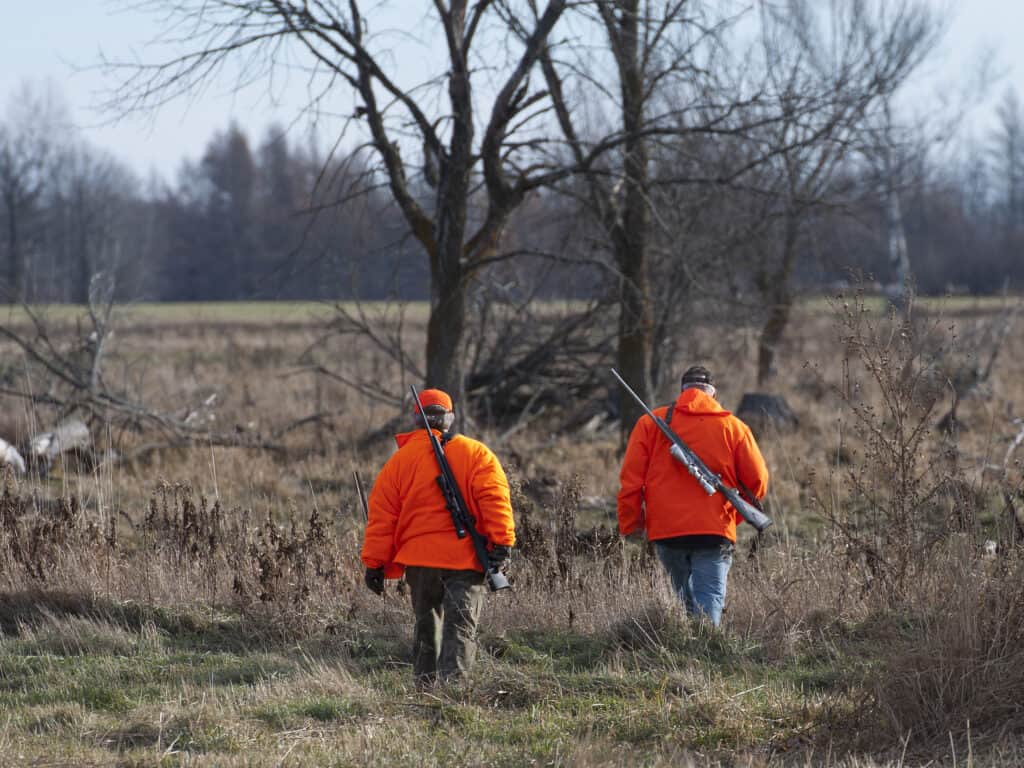Hunting in Virginia isn’t all that different than in other states. You’ll need a license, which requires taking a hunter education class. There are also several other classes you can take that are optional. However, these may be a good option for new hunters. There is also a hunting apprentice license, which you can get when being mentored.
Virginia has a significant deer population. Furthermore, there are several other big game animals you can hunt, as well. Many of these animals have similar regulations to deer. Therefore, once you know how deer hunting works, it is straightforward to cross over.
How to Get a Hunting License

A hunting license is required in Virginia before you can hunt anything in the state, including deer.
©Gary Gello/Shutterstock.com
Before you hunt anything in Virginia, you have to get a hunting license. These licenses are required for deer hunting – and for hunting anything else. There are a few steps you have to complete before getting these licenses, though.
Hunter Education
Before you can purchase a license, you must complete a hunter education course. There are several courses available. The first option involves both self-study and an in-person class. This course can be taken by anyone of all ages. However, it is required for hunters under 12.
You’ll have to complete your self-study portion of the class before the in-person class. Then, you’ll submit the exercises to the instructor before the class begins. The study materials are free and available at DWR offices and online.
Alternatively, you can sign up for an online adult hunter class. This class is completely online with no classroom requirement. The certificate is available online after you complete the class, which you can then complete.
Apprentice License
Instead of taking a hunter course, you can get an apprentice license instead. This license can only be purchased for two years in a row. During this time, the hunter must take an education course.
With this license, you can hunt under the supervision of a “mentor.” This mentor must be licensed or be exempt from licensing. You may hunt by yourself as soon as the course is complete, as long as you carry your certificate with you.
License Exceptions
While most people need a license to hunt, there are some exceptions. Here is a quick list:
- Resident landowners and their direct families do not need a license to hunt on their own land.
- Tenants and renters of land that they are residing on – as long as they have written permission from the landowner.
- Residents over the age of 65 do not need a license to hunt on private property.
- Residents under the age of 12. However, they must be directly supervised.
- Anyone who is aiding a disabled person in hunting but not hunting themselves.
- Any member of a tribe when hunting on tribal land. However, identification proving that the member is part of a tribe is required when hunting.
- Stockholders who own 50% or more of any domestic corporation owning land in Virginia, as well as their immediate family, do not need a license to hunt on this plant.
Types of Licenses Required for Hunting Deer
To hunt deer in Virginia, you need a general license and a deer license. You may also need permits to utilize certain land, so double-check before you go out hunting.
You also need an archery license to hunt with archery equipment. This license is particularly required when hunting during archery season, when only those with it are allowed to hunt. However, you should carry it whenever you are hunting with archery equipment.
A muzzleloading license is required to hunt with a muzzleloading firearm. There is a specific season for this hunting weapon.
Where to Purchase a License
You can purchase a license on the state’s website. You will need to create an account if you don’t already have one. This account requires quite a bit of different information, including your SSN or driver’s license number.
You may also purchase them from several licensed agents around the state. For instance, you can purchase them from some clerks and at the DWR headquarters. However, they are not sold at the DWR regional offices.
You may also order them through the app or via calling.
Once you purchase a license, it is valid for one year after the purchase date. However, deer licenses are only valid from July 1 to June 30 of the next year.
Bag Limits

Bag limits for deer hunting in Virginia differ by the part of the state in which you’re hunting. To the east, the bag limit is two a day and six a year, while in the west, the limit is two a day and only five a year.
©timotheos/Shutterstock.com
The bag limit differs between the eastern and western parts of the state. In the eastern area, the bag limit is two a day and six a year. No more than three of these may be antlered deer and at least three must be antlerless.
There are some exceptions. In many urban areas, the daily bag limit is unlimited. However, there may only be three antlered deer killed in this area, still. In National Forest lands and Department-owned lands, only one deer is allowed a day.
In the western part of the state, the bag limit is two a day and only five a year. Only two of these can be antlered. However, in cities and some towns, the daily limit is unlimited. Furthermore, only one deer may be taken from certain state-owned lands. In some areas, one buck must have at least four antler points.
You may use bonus permits to take more antlerless deer on private and some public lands. These tags do not count toward the daily or seasonal limit.
Antlered and Antlerless Deer

In Virginia, hunting antlered deer requires an either-sex deer tag. The only other option for deer tags is an antlerless-only tag.
©Tom Reichner/Shutterstock.com
Deer tags fall into two categories: either-sex deer tags and antlerless-only deer tags. These can only be used for the deer listed on the tag.
Antlered deer must have antlers visible above the hairline. These deer can only be taken with either-sex deer tags.
Antlerless deer are any deer that don’t fit the definition of an antlered deer. You may only take antlerless deer during specified seasons. Otherwise, only antlered deer can be taken. Male fawns and button bucks are considered antlerless deer, as you cannot see the antlers before taking a shot. Furthermore, these deer won’t grow antlers for another year.
You may use either tag for these deer.
Antler Point Restrictions
In some areas, there are restrictions for antlered deer. In these areas, the deer must have antlers of a predetermined size. For instance in Alleghany, Augusta, Bath, Highland, and Rockbridge counties, one of your bucks must have at least four points on one side if you kill at least two antlered deer.
In other words, your first buck can be of any size. However, your next one must fit this size requirement.
In Wildlife Management Areas, antlered deer must have at least four antler points of one inch or longer on one side. Be sure to check your map if you plan on hunting in one of these areas.
Earn a Buck

The EAB program allows hunters to earn hunting a buck by fulfilling requirements.
©iStock.com/Kerry Hargrove
The Earn a Buck (EAB) program allows you to “earn” an antlered deer by fulfilling certain requirements. These differ a bit from place to place, so be sure that you check the specific regulations in your area before you begin.
Some areas require you to take an antlerless deer on private land before taking your second buck on private land. In other words, you must earn your second buck by taking an antlerless deer.
In these same areas, you can sometimes earn a third deer by taking another antlerless deer. This way, the state helps keep the deer population contained.
In other areas, the rules are slightly different. For instance, sometimes you have to take two antlerless deer before taking the buck, and then three antlerless deer before taking your third buck.
It’s important to remember that these EAB programs are within a specific town, county, or hunting area. Therefore, you must harvest all deer from the same area. You can not spread them throughout the state.
Hunting Hours
Usually, hunting hours are one half-hour before sunrise to one-half hour after sunset. Often, this is about when it starts getting light outside. However, be sure to check the official sunrise and sunset dates in the Virginia hunting handbook, as these are what the laws are based on.
The only exception is for nuisance animals, which may be taken at any time. However, the definition for this is extremely strict.
Hunting is allowed on Sundays except on very specific occasions. You must not be within 200 yards of a church, and you must not use dogs. Otherwise, hunting is allowed.
Blaze Color Requirements
You are required to wear blaze orange or pink any time you are hunting during a firearm season – even if you aren’t using a firearm. The color must be visible from all angles. Accepted clothing includes anything worn on the upper body and a hat. The display must be at least 100 square inches in total.
Hats must only have the blaze coloration to count. They may also not be “camo” style. You may have a logo on your hat as long as it doesn’t detract from visibility.
You must also add blaze orange to any blind that is viewable from all sides. Putting blaze orange directly above the blind also counts. It must be at least 100 square inches of coloration. This requirement is in addition to the blaze color worn by the individual hunter.
Type of Seasons

Multiple deer hunting seasons in Virginia each come with a unique set of rules.
©Scharfsin/Shutterstock.com
There are several different deer seasons, each having its own rules. What weapons you can use, as well as the deer you can take, depend on the season. Therefore, it’s vital to understand when seasons start and end in your area.
Youth and Apprentice Deer Hunting Weekend
This particular weekend is a special season designed only for youth and apprentice deer hunters. It is statewide and takes place in most areas. During this time, anyone 15 or younger may hunt when under the supervision of a licensed 18-year-old or older hunter.
Apprentice hunters may also hunt during this time. However, they must also be under supervision.
You may take deer of either sex. The exact number will depend on your daily and yearly bag limit. All deer harvested count towards this bag limit.
Adults accompanying the hunters must not carry or discharge a weapon. They must also remain in close contact with the person in case they must take control of the firearm. Beyond this, all normal regulations apply.
Archery Deer Season

Virginia holds archery deer hunting season from October until the middle of November, and then again in December until the beginning of January.
©ZoranOrcik/Shutterstock.com
Archery deer season is typically from the beginning of October until the middle of November. There is also a late archery season that occurs from December until the beginning of January. These seasons have similar regulations despite the short break between them.
Different reasons may have different dates. Early archery season is typically the same statewide, but the late archery season can vary in start date.
You may take a deer of either sex at some locations. In other locations, only bucks are allowed. In urban areas, only antlerless deer are allowed. Be sure to check the bag limit for your area before hunting.
Urban archery season is often much earlier than other seasons – as early as September. Therefore, if you’re interested in this season, you’ll need to have everything squared away much earlier.
During archery season, you can only use archery gear. Those with a disability that prevents them from using a bow or crossbow correctly may utilize an airgun with special permission.
All broadhead arrows must be at least 7/8 inches wide or expand upon inches to that length. You may not lace the arrowheads with any chemical, drug, or toxic substance (this would contaminate the deer meat). You may not use dogs for hunting, though tracking dogs for wounded game are allowed. Except when muzzleloading season overlaps with archery season, you may not have a firearm.
Muzzleloader Deer Season
During this season, you may hunt with a qualifying muzzleloader rifle. However, this season doesn’t occur everywhere. Therefore, it’s vital to look at the dates and regulations in your area. You must wear blaze orange during this season.
Early muzzleloader season occurs in November. You may take antlered deer every day during this season. You may only take antlerless deer on either-sex hunting days. These only occur in very specific areas, though they are almost always allowed to be taken on private land. However, be sure to check the particular bag limits for the unit you’re hunting in.
Late muzzleloader season occurs from the end of December to the beginning of January. Once again, there are specific antlerless deer taking days in some areas. You cannot take an antlerless deer all the time, though antlered deer may be taken.
There are specific regulations for each type of muzzleloader that can be used. For instance, rifles must be at least .40 caliber, fire a single projective, and be loaded through the muzzle. Shotguns must be no larger than 10 gauge and also be loaded through the barrel. For each type of muzzleloading firearm, be sure that your gun meets the state’s requirements.
Electronic, flintlock, and percussion ignitions are permitted. Others are not. You must also not possess any other firearm during this season (unless you have a valid concealed handgun permit, in which case you may carry a handgun for protection).
If your weapon was specifically designed for smokeless powder, you may use it. However, using it in weapons that were not designed for it can be dangerous. Scopes are permitted, as are pneumatic arrow guns.
Firearm Deer Season

While firearm season for deer hunting in Virginia is popular, it comes with some caveats.
©Steve Oehlenschlager/Shutterstock.com
This deer season is the most popular, but it is also the most complicated. The dates differ throughout the state, as do the bag limits. In some cases, you must use the EAB program to earn more bucks by shooting antlerless deer. In other areas, you may shoot antlerless deer during the late part of this season. Sometimes, there are special regulations that apply.
Some areas do have mandatory CWD testing. However, most do not fall into this category. Sometimes, small strips of land of different regulations than the rest of the unit. Be sure to look at the maps and know where you’re hunting. It is very easy to wander over to other areas.
You may take antlered deer any day of the season. However, you must adhere to EAB regulations in some areas. Antlerless deer are a bit more complicated and can only be taken on certain days, which varies from area to area.
Overall, the regulations in this season really vary from county to county. Therefore, we recommend looking up the regulations in your particular county before you go hunting.
Up Next…
The photo featured at the top of this post is © Rui Serra Maia/Shutterstock.com
Sources
- Virginia Department of Wildlife Resources, Available here: https://dwr.virginia.gov/hunting/regulations/general/
- Virginia Department of Wildlife Resources, Available here: https://dwr.virginia.gov/hunting/regulations/
- Virginia Department of Wildlife Resources, Available here: https://dwr.virginia.gov/hunting/regulations/deer/
Thank you for reading! Have some feedback for us? Contact the AZ Animals editorial team.






